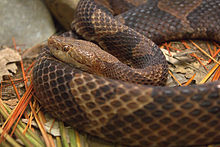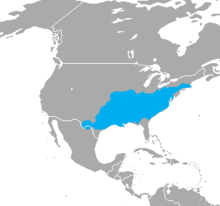
Hi Everybody!!
You may think a headless snake is a bizarre opening photo and you would be correct! As you know, I have a one leg buzzard who has moved in to the memory garden. I have been feeding birds for many years, but I have never fed the buzzards as they go hunt then return at night. They eat dead animals, not living ones. So this copperhead snake was experiment 104 of what does Cassidy like to eat. I chopped the head off and buried it (like Dad taught me). Anyway, I put the fresh dead snake on her picnic table for lunch. She did not eat it. She threw it on the ground. I am marking snake off the menu board for Cassidy. I have shared info below from Wikipedia about copperhead snakes. If you live near or go to woods in the South (States), you really should know about this snake.


https://en.wikipedia.org/wiki/Agkistrodon_contortrix
Agkistrodon contortrix
From Wikipedia, the free encyclopedia
| Agkistrodon contortrix | |
|---|---|
 | |
| Conservation status | |
| Scientific classification | |
| Kingdom: | Animalia |
| Phylum: | Chordata |
| Subphylum: | Vertebrata |
| Class: | Reptilia |
| Order: | Squamata |
| Suborder: | Serpentes |
| Family: | Viperidae |
| Subfamily: | Crotalinae |
| Genus: | Agkistrodon |
| Species: | A. contortrix |
| Binomial name | |
|---|---|
| Agkistrodon contortrix (Linnaeus, 1766) | |
 |
Description[edit]
Adults usually grow to a total length (including tail) of 50–95 cm (20–37 in), although some may exceed 1 m (3.3 ft). Males are usually larger than females. The maximum length reported for this species is 134.6 cm (53.0 in) for A. c. mokasen (Ditmars, 1931). Brimley (1944) mentions a specimen of A. c. mokasen from Chapel Hill, North Carolina, that was "four feet, six inches" (137.2 cm), but this may have been an approximation. The maximum length for A. c. contortrix is 132.1 cm (52.0 in) (Conant, 1958).[3]
The body is relatively stout and the head is broad and distinct from the neck. Because the snout slopes down and back, it appears less blunt than that of the cottonmouth, A. piscivorus. Consequently, the top of the head extends further forward than the mouth.[4]
The scalation includes 21–25 (usually 23) rows of dorsal scales at midbody, 138–157 ventral scales in both sexes and 38–62/37–57 subcaudal scalesin males/females. The subcaudals are usually single, but the percentage thereof decreases clinally from the northeast, where about 80% are undivided, to the southwest of the geographic range where as little as 50% may be undivided. On the head there are usually 9 large symmetrical plates, 6–10 (usually 8) supralabial scales and 8–13 (usually 10) sublabial scales.[3]
The color pattern consists of a pale tan to pinkish tan ground color that becomes darker towards the foreline, overlaid with a series of 10–18 (13.4) crossbands. Characteristically, both the ground color and crossband pattern are pale in A. c. contortrix. These crossbands are light tan to pinkish tan to pale brown in the center, but darker towards the edges. They are about 2 scales wide or less at the midline of the back, but expand to a width of 6–10 scales on the sides of the body. They do not extend down to the ventral scales. Often, the crossbands are divided at the midline and alternate on either side of the body, with some individuals even having more half bands than complete ones. A series of dark brown spots is also present on the flanks, next to the belly, and are largest and darkest in the spaces between the crossbands. The belly is the same color as the ground color, but may be a little whitish in part. At the base of the tail there are 1–3 (usually 2) brown crossbands followed by a gray area. In juveniles, the pattern on the tail is more distinct: 7–9 crossbands are visible, while the tip is yellow. On the head, the crown is usually unmarked, except for a pair of small dark spots, one near the midline of each parietal scale. A faint postocular stripe is also present; diffuse above and bordered below by a narrow brown edge.[4]
Several aberrant color patterns for A. c. contortrix, or populations that intergrade with it, have also been reported. In a specimen described by Livezey (1949) from Walker County, Texas, 11 of 17 crossbands were not joined middorsally, while on one side three of the crossbands were fused together longitudinally to form a continuous undulating band, surmounted above by a dark stripe that was 2–2.5 scales wide. In another specimen, fromLowndes County, Alabama, the first three crossbands were complete, followed by a dark stripe that ran down either side of the body, with points of pigment reaching up to the midline in six places but never getting there, after which the last four crossbands on the tail were also complete. A specimen found in Terrebonne Parish, Louisiana by Ernest A. Liner, had a similar striped pattern, with only the first and last two crossbands being normal.[4]
Common names[edit]
Common names for A. contortrix include: copperhead (snake), chunk head, death adder,[citation needed] highland moccasin, (dry-land) moccasin, narrow-banded copperhead, northern copperhead, pilot snake, poplar leaf, red oak, red snake, southeastern copperhead, white oak snake,[5]American copperhead,[6] southern copperhead,[4] and cantil cobrizo (Spanish).[2]
Geographic range[edit]
It is found in the United States in the states of Alabama, Arkansas, Connecticut, Delaware, Florida, Georgia, Illinois, Indiana, Iowa, Kansas, Kentucky,Louisiana, Ohio, Oklahoma, Maryland, Massachusetts, Mississippi, Missouri, New Jersey, New York, North Carolina, Pennsylvania, South Carolina,Tennessee, Texas, Virginia and West Virginia. In Mexico, it occurs in Chihuahua and Coahuila. The type locality is "Carolina". Schmidt (1953) proposed the type locality be restricted to "Charleston, South Carolina".[1]
Unlike some other species of North American pit vipers, such as Crotalus horridus and Sistrurus catenatus, Agkistrodon contortrix has not reestablished itself north of the terminal moraine after the last glacial period (the Wisconsin glaciation),[7] except it is found in southeastern New York State and southern New England, an area north of Long Island (the terminal moraine of the Wisconsin glaciation).
Habitat[edit]
Within its range it occupies a variety of different habitats. In most of North America it favors deciduous forest and mixed woodlands. It is often associated with rock outcroppings and ledges, but is also found in low-lying swampy regions. During the winter it hibernates in dens, in limestone crevices, often together with Timber Rattlesnakes and Black Rat Snakes. In the states around the Gulf of Mexico, however, this species is also found inconiferous forest. In the Chihuahuan Desert of west Texas and northern Mexico, it occurs in riparian habitats, usually near permanent or semipermanent water and sometimes in dry arroyos (brooks).[3]
Conservation status[edit]
This species is classified as Least Concern (LC) on the IUCN Red List of Threatened Species (v3.1, 2001).[8] Species are listed as such due to their wide distribution, presumed large population, or because it is unlikely to be declining fast enough to qualify for listing in a more threatened category. The population trend was stable when assessed in 2007.[9]
Behavior[edit]
Like all pit vipers, A. contortrix is generally an ambush predator: it takes up a promising position and waits for suitable prey to arrive. One exception to ambush foraging occurs when copperheads feed on insects such as caterpillars and freshly molted cicadas. When hunting insects, copperheads actively pursue their prey.[10] Juveniles use a brightly colored tail to attract frogs and perhaps lizards, a behavior termed caudal luring (see video: [1]). In the southern United States, they are nocturnal during the hot summer months, but are commonly active during the day during the spring and fall.
Like most North American viperids, these snakes prefer to avoid humans and, given the opportunity, will leave the area without biting. However, unlike other viperids they will often "freeze" instead of slithering away, and as a result many bites occur from people unknowingly stepping on or near them.[11] This tendency to freeze most likely evolved because of the extreme effectiveness of their camouflage. When lying on dead leaves or red clay, they can be almost impossible to notice. They will frequently stay still even when approached closely, and will generally strike only if physical contact is made.
Feeding[edit]
Roughly 90% of its diet consists of small rodents, such as mice and voles. They have also shown fondness for large insects and frogs, and though highly terrestrial, have been known to climb trees to gorge on emerging cicadas.
Reproduction[edit]
A. contortrix breeds in late summer, but not every year: sometimes a female will produce young for several years running, then not breed at all for a time. They give birth to live young, each of which is about 20 cm (7.9 in) in total length. The typical litter size is 4 to 7, but there can be as few as one, or as many as 20. Their size apart, the young are similar to the adults, but lighter in color, and with a yellow-marked tip to the tail, which is used to lure lizards and frogs.
A study has shown that A. contortrix males have longer tongue tine lengths than females during the breeding season which may aid in chemoreception of males searching for females.[12]
Venom[edit]
Although venomous, these snakes are generally not aggressive and bites are rarely fatal.[citation needed] Copperhead venom has an estimated lethal dose of around 100 mg, and tests on mice show its potency is among the lowest of all pit vipers, and slightly weaker than that of its close relative, the cottonmouth.[citation needed] Copperheads often employ a "warning bite" when stepped on or agitated and inject a relatively small amount of venom, if any at all. "Dry bites" involving no venom are particularly common with the copperhead, though all pit vipers are capable of a dry bite.[citation needed]
Bite symptoms include extreme pain, tingling, throbbing, swelling, and severe nausea. Damage can occur to muscle and bone tissue, especially when the bite occurs in the outer extremities such as the hands and feet, areas in which there is not a large muscle mass to absorb the venom. A bite from any venomous snake should be taken very seriously and immediate medical attention sought, as allergic reaction and secondary infection are always possible.
The venom of the southern copperhead has been found to hold a protein called "contortrostatin" that halts the growth of cancer cells in mice and also stops the migration of the tumors to other sites.[13] However, this is an animal model, and further testing is required to verify safety and efficacy in humans.[14]
Although technically the antivenin CroFab could be used to treat an envenomation, it is usually not administered for copperheads, as the risk of complications of an allergic reaction to the treatment are greater than the risk from the snakebite itself in most cases. The antivenin can cause an immune reaction called serum sickness, which can consist of bouts of flu like symptoms for 1-12 months. Pain management, antibiotics, and medical supervision in the case of complications is usually the course of action.[15] In 2002, an Illinois poison control center report on the availability of antivenin stated it used 1 Acp to 5 Acp depending on the symptoms and circumstances. The symptoms of a mild envenomation include swelling of the hand, mild cellulitis, and respiratory distress. The symptoms of a moderate envenomation would include swelling of the hand, vomiting, mild bleeding, ecchymosis, diaphoresis, sinus tachycardia, and hypotensia.[16]


https://plus.google.com/u/0/photos/117645114459863049265/albums/6053444711644771505








link to G+ photo albums:
https://plus.google.com/u/0/photos/117645114459863049265/albums/6053449135361597873

...this is brendasue signing off from Rainbow Creek. See you next time! If you venture into the southern woods, watch out for the copperheads.

O+O




















